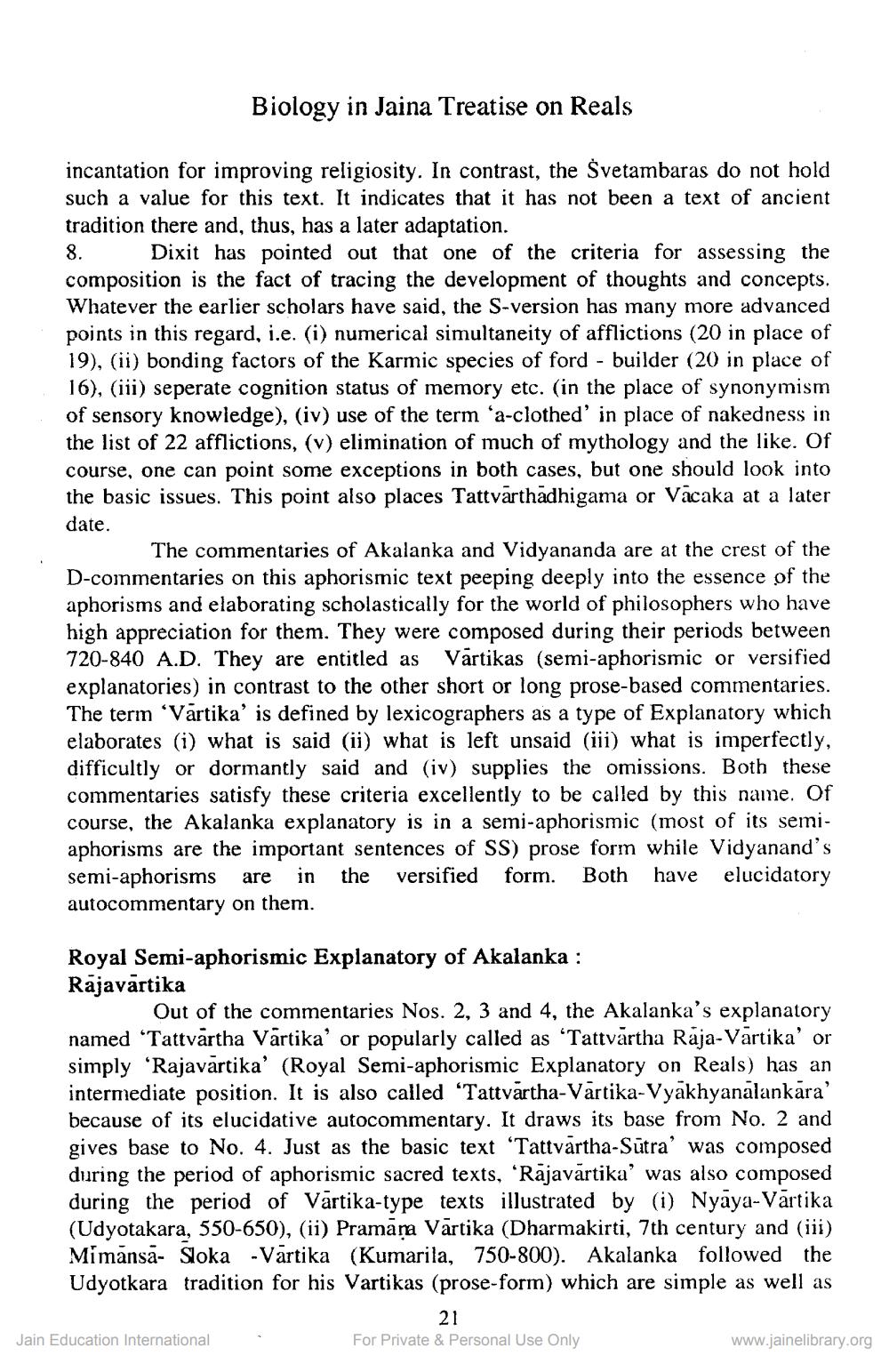________________
Biology in Jaina Treatise on Reals
incantation for improving religiosity. In contrast, the Svetambaras do not hold such a value for this text. It indicates that it has not been a text of ancient tradition there and, thus, has a later adaptation. 8. Dixit has pointed out that one of the criteria for assessing the composition is the fact of tracing the development of thoughts and concepts. Whatever the earlier scholars have said, the S-version has many more advanced points in this regard, i.e. (i) numerical simultaneity of afflictions (20 in place of 19), (ii) bonding factors of the Karmic species of ford - builder (20 in place of 16), (iii) seperate cognition status of memory etc. (in the place of synonymism of sensory knowledge), (iv) use of the term 'a-clothed' in place of nakedness in the list of 22 afflictions, (v) elimination of much of mythology and the like. Of course, one can point some exceptions in both cases, but one should look into the basic issues. This point also places Tattvarthadhigama or Vacaka at a later date.
The commentaries of Akalanka and Vidyananda are at the crest of the D-commentaries on this aphorismic text peeping deeply into the essence of the aphorisms and elaborating scholastically for the world of philosophers who have high appreciation for them. They were composed during their periods between 720-840 A.D. They are entitled as Vārtikas (semi-aphorismic or versified explanatories) in contrast to the other short or long prose-based commentaries. The term 'Vartika' is defined by lexicographers as a type of Explanatory which elaborates (i) what is said (ii) what is left unsaid (iii) what is imperfectly, difficultly or dormantly said and (iv) supplies the omissions. Both these commentaries satisfy these criteria excellently to be called by this name. Of course, the Akalanka explanatory is in a semi-aphorismic (most of its semiaphorisms are the important sentences of SS) prose form while Vidyanand's semi-aphorisms are in the versified form. Both have elucidatory autocommentary on them.
Royal Semi-aphorismic Explanatory of Akalanka : Rajavartika
Out of the commentaries Nos. 2, 3 and 4, the Akalanka's explanatory named 'Tattvārtha Vārtika' or popularly called as 'Tattvārtha Raja-Vārtika' or simply 'Rajavartika' (Royal Semi-aphorismic Explanatory on Reals) has an intermediate position. It is also called "Tattvartha-Vartika-Vyakhyanalankara' because of its elucidative autocommentary. It draws its base from No. 2 and gives base to No. 4. Just as the basic text "Tattvartha-Sutra' was composed during the period of aphorismic sacred texts, 'Rajavartika' was also composed during the period of Vārtika-type texts illustrated by (i) Nyaya-Vārtika (Udyotakara, 550-650), (ii) Pramāra Vārtika (Dharmakirti, 7th century and (iii) Mimānsā- Sloka -Vārtika (Kumarila, 750-800). Akalanka followed the Udyotkara tradition for his Vartikas (prose-form) which are simple as well as
21 Jain Education International For Private & Personal Use Only
www.jainelibrary.org




